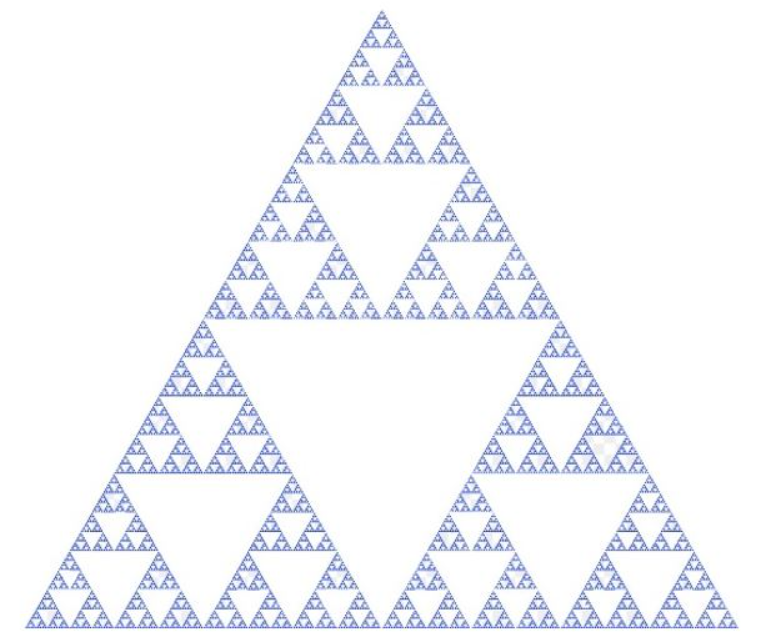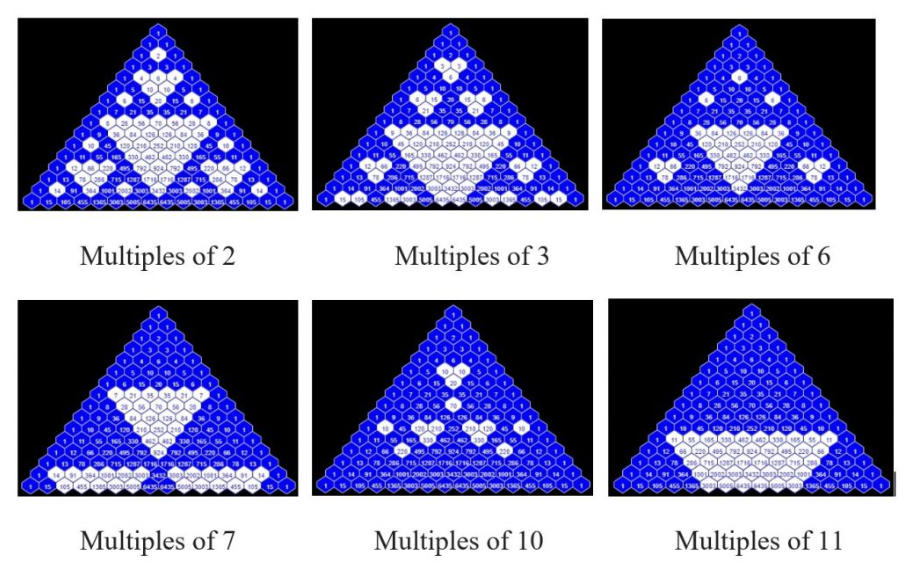The Mathematical Secrets of Pascal's Triangle


The Double Pendulum is useful in regards to Chaos Theory as it shows that tiny changes in parameters (i.e., gravity, mass of both objects, lengths of each string) effect the position of the second mass changes. The calculations come from the equations and uses of this webpage that dives deeper into the double pendulum. Although a single pendulum is predictable, the double pendulum is very difficult, and follows a non-linear equation.
Some questions for exploring:
The orange mass is dependent upon the green mass. The orange mass follows the lines of the circles (as shown when you select "Show Circle Limits"). The green mass does not go beyon the green circle limits, but the green mass can go inside the orange circle. The trace of the green mass shows a non-linear pattern. It's pattern is highly dependent upon each variable. As such, any change causes the trace of the green mass to change significantly, especially as time increases.
Answer the following questions:
What changes occur when \(a\) gets larger or smaller in the equation \(f(x) = a \sin(bx)\)?
What changes occur when \(b\) gets larger or smaller in the equation \(f(x) = a \sin(bx)\)?
In the applet, what happens when \(a = -1\) and \(b = 1\)? when \(a = 1\) and \(b = -1\)? What do you notice when both \(a = -1\) and \(b = -1\)? Compare these to \(g(x) = \sin(x)\).
| Title | Description |
|---|---|
| Double Pendulum | This applet represents a double pendulum which ties closely to Chaos Theory. The applet also contains graphical visuals of the double pendulum swinging. The rest of the page contains different equations and numerical explanations to the way the pendulum moves. |
| The Mandelbrot and Julia sets. Introduction. | A webpage with various interactive images. Each image is a fractal. As the user clicks among the image, they can zoom in to see that the fractal continues on forever. The Mandelbrot Set helps demonstrate Chaos Theory, so these fractals align nicely to describe Chaos Theory. This site has multiple interactive images and applets to explain Chaos Theory. |
| The Chaos Game | This applet uses probability using different vertices and how likely a ball will roll to that vertice based on probability. The applet has different tabs to explain the concept, use the applet, and has a help tab as well as instructor information. The website links to more applets and real-life examples of Chaos Theory. |
| Dragon Curve Generator | This applet allows learners to better understand the dragon curve, a type of fractal. Since fractals and Chaos Theory work hand-in-hand, an explanation on how they are related as well as an applet in accordance with a fractal adds variation to the subject. |
| Foxes and rabbits | This applet follows Applied Mathematics and Ordinary Differential Equations, but also applies to Chaos Theory. The applet addresses some values for specific variables and how the number of foxes and rabbits change based on one another's population. For example, if there are too many foxes, the rabbit population will decrease. The way this applies to Chaos Theory is an ecosystem relies on many small variations, but one tiny difference could cause a completely unpredictable final outcome. |
| Title | Description |
|---|---|
| Rossman/Chance Applet Collection | A collection of statistical applets designed for college statistics. These applets are grouped into statistical categories. Some of the applets contain datasets, while others allow us to create values for various parameters resulting in graphs or visuals that relate to statistics. |
| Physics Simulations | Although this collections falls under the term of physics, all of these applets associate the physics into mathematical graphs and equations. Likewise, some of these applets apply to Chaos Theory. |
| Apps on Mathematics by Walter Fendt | This collection contains multiple applets that are beneficial for K-12 students, and even into college mathematics. The applets are bright, colorful, and user friendly. They are grouped into subjects within mathematics, including algebra and geometry. |
| Math, physics, and engineering applets | A group of applets to visualize concepts in math, physics, and engineering. Most of the visuals can be changed ever so slightly to get a different outcome, based on different numerical values. |
| Applets for Calculus | A number of Calculus applets for college students to better visualize topics of Calculus. Each applet is interactive through clicking along the Cartesian coordinate plane. |
| Title | Type | Description |
|---|---|---|
| Chaos: The Science of the Butterfly Effect | YouTube video | A video that simply explains the origins of Chaos Theory and helps one better understand the meaning of Chaose Theory. |
| Chaos Theory | YouTube video | An older video used to explain the basics of Chaos Theory. Physical models are shown to display Chaos and the unpredictability behind it. |
| Chaos | Research Article | A published article from Standford that defines, applies, and discusses Chaos theory. |
| Jurassic Park (1993) - Chaos Theory Scene | Movie Clip from Jurassic Park on YouTube | I first learned about Chaos Theory while reading Jurassic Park, and the movie Jurassic Park contains some of the explanation on Chaos Theory. Dr. Ian Malcom, the mathematician, explains Chaos Theory as "unpredictability in complex systems." One of the ways he explains it is with a droplet of water at the top of your hand. You never know exactly where the drop of water will fall because of tiny differences in the system. This is a way to describe Chaos Theory. |
| What is Chaos Theory? | Webpage | A website about Fractals that explores Chaos Theory. It discusse some applications of chaos. There is also a gif of the Dragon Curve which is a fractal commonly associated with chaos. Other links on Chaos are provided, as well. |
| The Mathematical Beauty of Patterns in Chaos Theory | Webpage | Another website that describes the patterns and explanations behind these patterns (specifically using mathematics). Some videos are provided to explain the equations. |